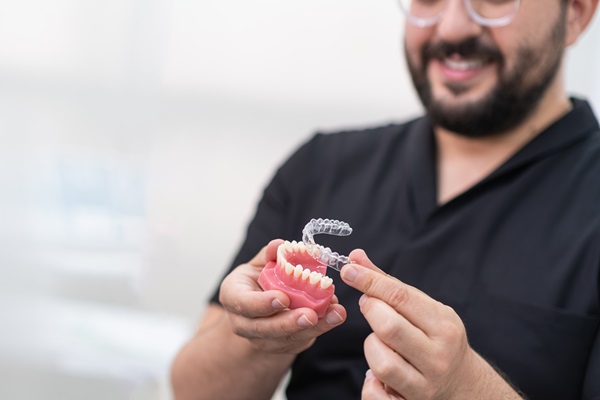5 FAQs About Clear Aligners

Clear aligners are a great orthodontic option that many general dentists are now offering. They are popular due to their flexibility, convenience, and ease; however, because they are still considered relatively new to dentistry, there are still a lot of questions regarding how they work and what the treatment process entails. Read on to learn more about clear aligners.
5 Frequently asked questions about clear aligners
Outlined below are a few frequently asked questions and answers regarding clear aligners. It can be helpful to review the following information when considering teeth straightening from a general dentist.
1. How long does clear aligner treatment last?
Clear aligners are different for each patient; however, for the most part, the treatment process does not last longer than a year. Patients that have mild to moderate orthodontic issues are much more likely to respond better to clear aligners, as they do not require lengthy treatment as is typically the case with braces.
2. Do clear aligners hurt?
Most patients report little to no discomfort with clear aligners. Of course, there will be some slight soreness when treatment first begins; however, unlike braces, clear aligners are easier on the mouth, which results in less soreness and pain. Any soreness can be remedied with over-the-counter medications, and it is not likely to persist for more than three days.
3. How often do clear aligners have to be changed?
Like other teeth-straightening methods, clear aligners are adjusted every six to eight weeks. Patients will visit the general dentist for an examination and check-in. The dentist will check on their progress and provide the patient with the next set of aligners, which will all have been custom-created in a dental lab before the process has started. Recent dental technology allows for the custom-creation of an entire series of clear aligners, which are based on the patient's goals.
4. Are clear aligners removable?
Yes. Clear aligners are removable trays, which makes them convenient to use and much easier on the soft tissues of the mouth. However, because they are removable, it is important to understand that there is a certain level of discipline required when undergoing treatment. Clear aligners have to be worn for at least 22 hours a day to ensure effective results.
5. Is there any special care while wearing clear aligners?
No. Patients wearing clear aligners are encouraged to practice good oral hygiene every day, including brushing, flossing, and rinsing. Brushing should be done twice a day or after every meal, and flossing should be done once a day. Because clear aligners are removable, they do not require any special care other than rinsing.
Getting started with clear aligners
When looking for more information on clear aligners, it is best to consult directly with a general dentist. An evaluation can be done, and any questions or concerns can be properly addressed, all of which will be used to determine the most suitable course of action. Contact us today to find out more or to get started with an appointment.
Request an appointment here: https://www.natdent.com or call Victor Zeines, DDS, MS at (212) 754-2222 for an appointment in our New York office.
Check out what others are saying about our dental services on Yelp: Clear Aligners in New York, NY.
Related Posts
Clear aligners are nearly invisible and allow people to straighten their teeth discreetly. Aligners are most suitable for patients who can commit to treatment. It is crucial to follow treatment guidelines for quick and effective results. Read on to learn more about your role in clear aligners treatments.Aligners are clear, plastic-like trays that are worn…
Understanding how clear aligners work is the first thing someone needs to do when considering these popular teeth straightening options. Because there are a few different straightening options to choose from due to updated dental technologies, those needing straightening services have a few choices. Clear aligners are one of the popular options people are choosing.Understanding…
Cavities are simply a part of life. We eat food, which turns into sugars, which can feed off our teeth if we do not properly brush and floss away the residue. If you do end up with a cavity, it can easily be remedied with a visit to the dentist and modern dental technology. Back…
Holistic dentistry is a natural form of dental care. More and more people are recognizing this practice as a healthier form of treating and preventing oral issues. Staying clear of chemicals can give oral solutions that involve the mind and body as well. Here are the things to consider in understanding holistic dentistry principles.This type…
